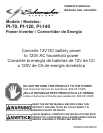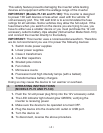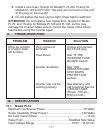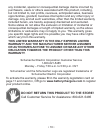
• 6 •
engine. To maintain battery power, start the engine every 2 to 3 hours
and let it run for approximately 30 minutes to recharge the battery.
Although it is not necessary to disconnect the inverter when turning
over the engine, it may briey cease to operate as the battery voltage
decreases. While the inverter draws very low amperage when not in
use, it should be unplugged to avoid battery drain.
LED INDICATOR AND SHUTDOWN PROTECTION7.
The LED glows GREEN automatically when plugged into a 12-volt
DC source and will not glow under the following conditions (NOTE:
On Model PI-120 a BLUE LED will glow):
When the power input from the vehicle’s battery drops to 1.
approximately 10-volts, low battery shutdown occurs and
inverter shuts off. Solution: Recharge or replace the battery.
When the power input from the vehicle’s battery exceeds 2.
15-volts, high voltage protection occurs. Solution: Reduce the
voltage range to between 12-volts and 14-volts.
The continuous load demand from the equipment or device 3.
being operated exceeds the continuous load rating of the
inverter being used. Solution: Use a higher capacity inverter or
lower rated device.
The case temperature becomes hot (exceeds 145°F). Solution: 4.
Allow the inverter to cool. Do not block the cooling slots or air
ow over and through the inverter. Reduce the load on the
inverter to the continuous rated output.
RESET: To reset after shutdown occurs, remove the 12-volt plug from
the accessory outlet. Check the source of the problem and correct.
Reinsert the 12-volt plug into the accessory outlet.
IF THE INVERTER FUSE BLOWS8.
Your power inverter is tted with a fuse, which should not have to be
replaced under normal operating conditions. A blown fuse is usually
caused by reverse polarity or a short circuit within the device or
equipment being operated.
If the fuse does blow:
Disconnect the device or equipment immediately.1.
Find the source of the problem and repair it.2.


















